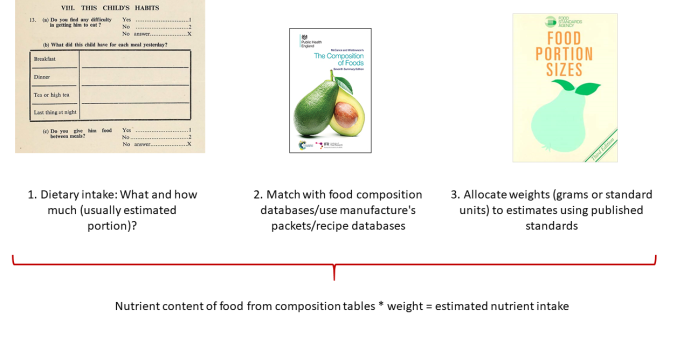- Estimating nutrient intakes from 24-hour recalls and diet diaries
- Estimating nutrient intakes from FFQs
Estimating nutrient intakes from 24-hour recalls and diet diaries
In general, the steps to extract nutrients from diet records are [6]:
- Select a food composition database: It is important to use time and population appropriate food composition databases as manufacturers can change formulation of food products over time. It is also often necessary to use more than one source and refer to manufacturers’ packets and recipe databases to code composite dishes e.g. lasagne.
- Match foods listed in the DAT with entries in the food composition database. This can involve grouping different food items together.
- If food/drinks are estimated in household measures, portion sizes in grams or standard units need to be allocated. This can be based on previously published standard portion sizes.
- Calculate the nutrients based on the food composition database and portion size.
- For unknown foods/groups or recipes where there is difficulty translating to appropriate food codes and/or weight, assumptions are often made with the input of a nutritionist/dietician.
Estimating nutrient intakes from food frequency questionnaires (FFQs)
- Select an appropriate food composition database (as above).
- Match foods listed in the DAT with entries in food composition database
- For FFQs that do not record amounts of foods, portion sizes need to be allocated (as above).
- Allocate frequency weights based on responses; weight of each food/group consumed = frequency (e.g. 1.0 for once a day)*portion size
- Total nutrient intake = ∑ (weight x nutrient content from food composition database)
In some cases, the nutrient content may be modified by responses to other questions, e.g. the brand of margarine used, or the type of cooking fat usually used or if fat is normally cut off meat.
Simplified representation of process to estimate nutrient intake from dietary assessment tools

Explore additional background detail:
Learn more about the individual studies covered by this guide and their dietary measurements:
- Overview of dietary information in selected CLOSER studies
- Hertfordshire Cohort Study (HCS)
- 1946 National Survey for Health and Development (NSHD)
- 1958 National Child Development Study (NCDS)
- 1970 British Cohort Study (BCS70)
- Understanding Society: The UK Household Longitudinal Study (UKHLS)
- The Avon Longitudinal Study of Parents and Children (ALSPAC)
- Southampton Women’s Survey (SWS)
- Millennium Cohort Study (MCS)
Learn about harmonisation in the context of dietary data:
Further information:
- Acknowledgements and copyright information for this guide
- References for this guide
- Download the full guide as a PDF
This page is part of the CLOSER resource: ‘A guide to the dietary data in eight CLOSER studies’.
